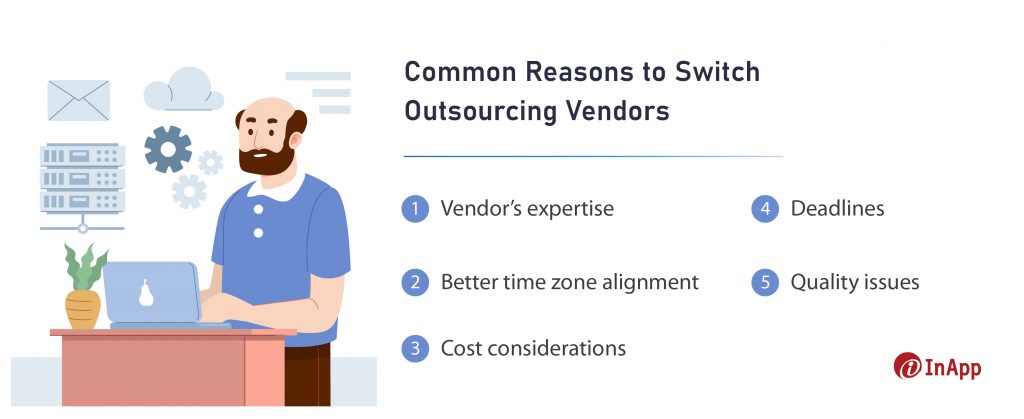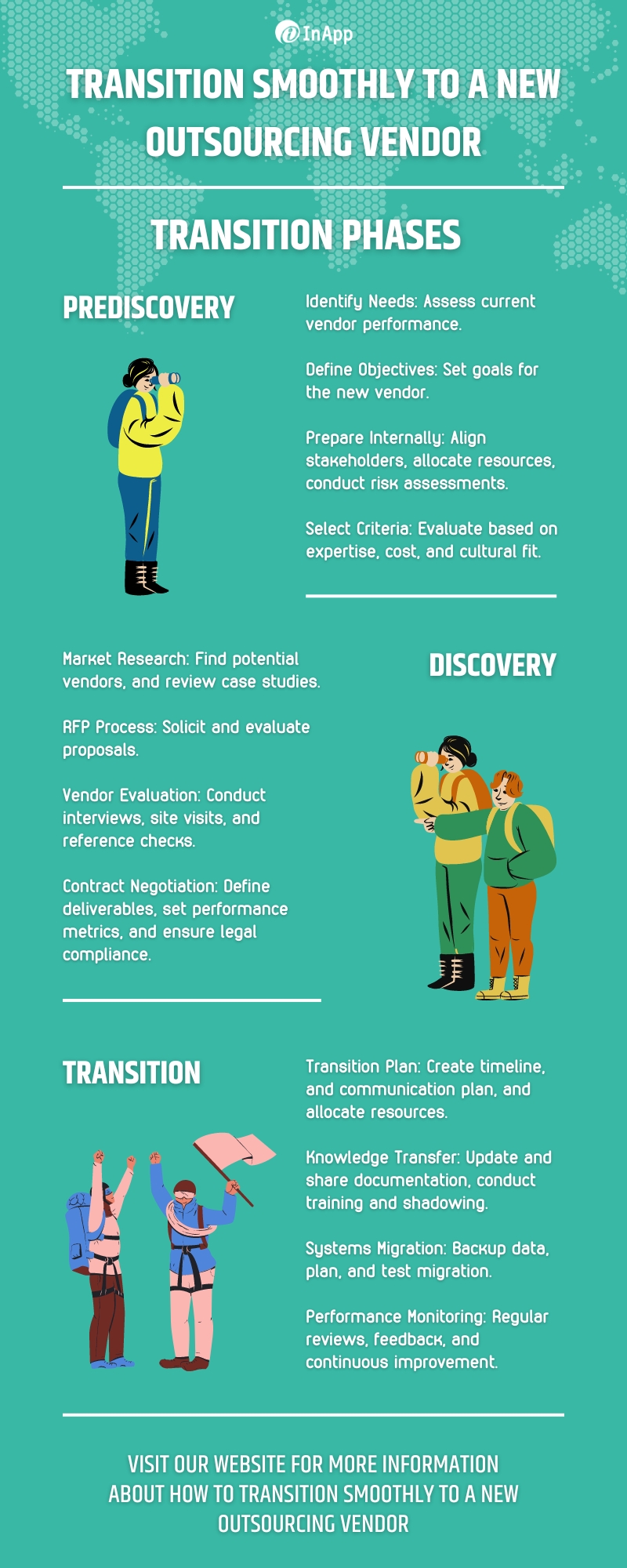Switching vendors can be challenging, especially when your organization has invested significant time and money in setting up processes, communication channels, and training with the current one. Regardless of how skilled your new team is, expecting them to take charge overnight is unrealistic. Whether the change is due to low-quality deliverables, cost overruns, or a lack of interpersonal chemistry, there’s one priority that stands above all else: your product.
Why do companies switch outsourcing vendors?
No company enters an agreement with an outsourcing vendor expecting to switch if things don’t work out. Typically, businesses engage with vendors hoping for a smooth, problem-free partnership. However, various reasons can drive the decision to change vendors.
One common reason for switching is the need for better time zone alignment. As businesses expand globally, having a vendor in a compatible time zone can significantly enhance communication and efficiency. Misaligned time zones can lead to delays and misunderstandings, ultimately affecting the project’s success.

Another critical factor is the vendor’s expertise, or lack thereof, in a specific technology. As technological landscapes evolve, a company may find its current vendor lacks the necessary skills to support new initiatives. In such cases, switching to a vendor with the required expertise becomes imperative to maintain a competitive edge.
Cost considerations also play a significant role. Sometimes, companies discover they are paying more than the market rate for subpar services. Finding a more cost-effective vendor without compromising quality can lead to substantial savings and better resource allocation.
The inability to meet deadlines is another major issue. Timely delivery is crucial in maintaining the operational flow and meeting market demands. If a vendor consistently fails to meet deadlines, it can lead to significant disruptions and lost opportunities, prompting companies to seek more reliable partners.
For instance, we had a client who decided to switch vendors due to quality issues. They had outsourced their software testing services, but the vendor failed to catch numerous errors and bugs and had limitations in automated testing. These overlooked errors compromised the software’s reliability and user experience. Frustrated by these shortcomings, the client terminated their agreement and turned to InApp for more reliable testing services. Our team provided comprehensive testing solutions, addressing both manual and automated testing needs, ultimately improving the software’s quality and performance.
Transitioning to a New Outsourcing Vendor
Transitioning to a new outsourcing vendor is a multifaceted process that requires careful planning and execution.
This process can be divided into three main phases:
- Prediscovery
- Discovery
- Transition

1. Prediscovery Phase
The prediscovery phase is the initial stage where preliminary planning and assessments take place. This phase sets the foundation for a successful transition by identifying needs, defining objectives, and preparing internally.
Identifying Needs and Objectives
Before embarking on the journey of switching vendors, it’s essential to identify the reasons behind the change.
- Assessing Current Vendor Performance: Evaluate the current vendor’s performance in terms of quality, timeliness, cost, and communication. Identify specific areas where the vendor is falling short.
- Defining Objectives: Establish clear objectives for the new vendor. These could include improved quality, better cost efficiency, enhanced technological capabilities, or more effective communication.
Internal Readiness
Preparing internally is critical for a smooth transition. This involves ensuring stakeholder alignment, allocating necessary resources, conducting a thorough risk assessment, and establishing clear communication channels to manage the transition effectively.
- Stakeholder Engagement: Engage all relevant stakeholders, including senior management, department heads, and team members, to ensure alignment on the decision to switch vendors.
- Resource Allocation: Identify and allocate resources required for the transition, including personnel, budget, and time.
- Risk Assessment: Conduct a thorough risk assessment to identify potential challenges and develop mitigation strategies.
Vendor Selection Criteria
Developing clear criteria for selecting a new vendor is essential. Some factors to consider include
- Expertise and Experience: Ensure the new vendor has the necessary expertise and experience in your industry and the required technologies. You should look at their portfolio and customer reviews.
- Cost and Value: Evaluate the cost structure and ensure it aligns with your budget while providing good value for money.
- Cultural Fit: Assess the cultural fit between your organization and the potential vendor to ensure smooth collaboration.
Discover our detailed guide on choosing the perfect outsourcing partner here
2. Discovery Phase
The discovery phase involves a detailed exploration and evaluation of potential vendors. This phase is crucial for selecting the right partner who meets your requirements and aligns with your business objectives.
Market Research
Conduct comprehensive market research to identify potential vendors.
- Vendor Listings: Utilize online platforms, industry directories, and professional networks to create a list of potential vendors.
- Case Studies and References: Review case studies and request references to gauge the vendor’s past performance and reliability.
Request for Proposal (RFP) Process
Issuing an RFP is a formal way to solicit detailed proposals from potential vendors. This involves
- Creating the RFP Document: The RFP should include your project requirements, objectives, timeline, budget, and evaluation criteria.
- Distributing the RFP: Send the RFP to shortlisted vendors and set a deadline for responses.
- Evaluating Proposals: Evaluate the received proposals based on predefined criteria such as expertise, cost, approach, and cultural fit.
Vendor Evaluation and Selection
After receiving and evaluating proposals, the next step is to select the most suitable vendor. This includes:
- Interviews and Presentations: Conduct interviews and request presentations from top contenders to better understand their capabilities and approach.
- Site Visits: If feasible, visit the vendor’s site to observe their operations and meet their team.
- Reference Checks: Conduct thorough reference checks by speaking to the vendor’s past and current clients.
Contract Negotiation
Once a vendor is selected, negotiate the contract terms to ensure they align with your expectations and requirements.
- Defining Deliverables: Clearly define the deliverables, milestones, and timelines.
- Setting Performance Metrics: Establish key performance indicators (KPIs) to measure the vendor’s performance.
- Legal and Compliance Considerations: Ensure all legal and compliance aspects are addressed in the contract.
3. Transition Phase
The transition phase is the final stage where the actual switch to the new vendor takes place. This phase requires meticulous planning and execution to minimize disruptions and ensure continuity.
Transition Planning
Developing a detailed transition plan is crucial for a seamless transition.
- Project Timeline: Create a detailed project timeline outlining all transition activities and milestones.
- Communication Plan: Develop a communication plan to keep all stakeholders informed throughout the transition process.
- Resource Allocation: Assign dedicated transition teams from both your organization and the new vendor to oversee the process.
Knowledge Transfer
Effective knowledge transfer is critical to ensure the new vendor is up to speed.
- Documentation: Ensure all relevant documentation, including project plans, process maps, and system architecture, is up-to-date and shared with the new vendor.
- Training Sessions: Conduct training sessions and workshops to familiarize the new vendor with your processes, tools, and systems.
- Shadowing: Implement a shadowing period where the new vendor’s team works alongside your current team to gain hands-on experience.
Systems and Data Migration
Migrating systems and data to the new vendor is a complex process that requires careful planning. This includes:
- Data Backup: Ensure all critical data is backed up before the migration process begins.
- Migration Plan: Develop a detailed migration plan outlining the steps, timeline, and responsible parties.
- Testing: Conduct thorough testing post-migration to ensure all systems and data are functioning correctly.
Performance Monitoring and Feedback
Once the transition is complete, ongoing performance monitoring is essential to ensure the new vendor meets your expectations.
- Regular Reviews: Conduct regular performance reviews to assess the vendor’s performance against the established KPIs.
- Feedback Mechanisms: Establish feedback mechanisms to gather input from all stakeholders and address any issues promptly.
- Continuous Improvement: Encourage continuous improvement by working closely with the new vendor to refine processes and enhance performance.
Bringing It All Together
Transitioning to a new outsourcing vendor is a complex but manageable process when approached with careful planning and execution. By following the prediscovery, discovery, and transition phases outlined above, organizations can minimize disruptions and ensure a smooth transition. With clear objectives, thorough evaluation, effective knowledge transfer, and continuous performance monitoring, the new vendor partnership can lead to improved efficiency, better quality, and enhanced business outcomes. If you are looking to switch to a new IT outsourcing vendor, get in touch with us. With over 20 years of experience working with clients across the globe on multiple projects spanning various industries, we have established processes to ensure a seamless transition with minimal disruption. Reach out to our team to learn how we can help your organization make a smooth and successful transition.
